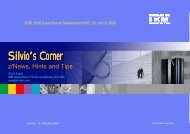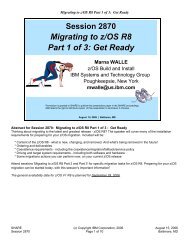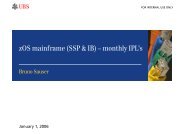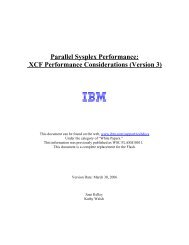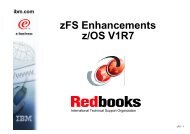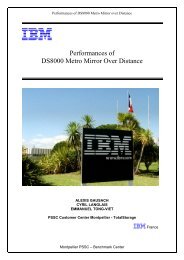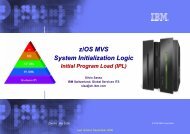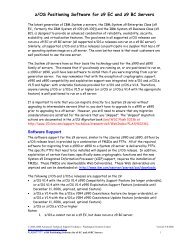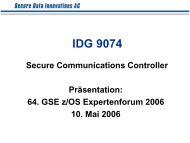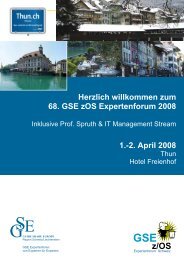Hot Topics - Messmer The Brain House
Hot Topics - Messmer The Brain House
Hot Topics - Messmer The Brain House
You also want an ePaper? Increase the reach of your titles
YUMPU automatically turns print PDFs into web optimized ePapers that Google loves.
of PDS and PDSE data sets, and data<br />
stored in z/OS UNIX System Services file<br />
systems. Entire PDS, PDSE, and VSAM<br />
data sets can be unloaded to sequential<br />
data sets using utilities (IEBCOPY and<br />
IDCAMS) to allow them to be encrypted.<br />
Using the hardware compression<br />
features available on IBM System z9 and<br />
zSeries servers, the Encryption Facility<br />
will optionally compress data before<br />
using other hardware features to encrypt<br />
it. (<strong>The</strong> Encryption Facility potentially<br />
leverages both Crypto Express2 and<br />
CPACF.) Compression is optional because<br />
the hardware compression algorithm is<br />
not supported in all environments where<br />
a tape might need to be read later. <strong>The</strong><br />
Encryption Feature can use ICSF as the<br />
key manager to centralize and help you<br />
control access to encryption key storage.<br />
<strong>The</strong>re are recovery procedures you can use<br />
for ICSF’s key storage to prevent key loss;<br />
see “Questions please…” on page 23, for<br />
more information.<br />
Data can be encrypted using TDES<br />
with triple-length keys or AES with 128bit<br />
keys. Every file can be encrypted with a<br />
different key. <strong>The</strong> key used to encrypt the<br />
file is then itself encrypted and stored in a<br />
file header record. To decrypt the file, the<br />
key used to encrypt the original encryption<br />
key is needed first. More about this later.<br />
DFSMSdss Encryption feature<br />
<strong>The</strong> DFSMSdss Encryption feature<br />
lets you encrypt DFSMSdss dump data<br />
sets. DFSMSdss, of course, will dump<br />
an entire volume, a single data set, or a<br />
group of data sets. DFSMSdss encryption<br />
supports the same hardware compression<br />
and encryption features and encryption<br />
algorithms as the Encryption Services<br />
feature, supports using ICSF for key<br />
management, and, like the Encryption<br />
Services feature, encrypts the key used<br />
to encrypt the data and writes it to the<br />
output data set. Also, when DFSMSdss is<br />
used as the data mover, it can encrypt data<br />
migrated by DFSMShsm .<br />
Encryption Facility can allow you to<br />
compress and encrypt data to be written<br />
to either tape or disk.<br />
Encryption Facility Client<br />
So—this sounds good so far, but how does<br />
the Encryption Facility let you exchange<br />
data with business partners running on<br />
other operating system platforms? By<br />
itself, it doesn’t. Enter the Encryption<br />
Facility Client, a separate, downloadable<br />
product. <strong>The</strong> Encryption Facility Client<br />
is an as-is, unwarranted product. For<br />
more information, see ibm.com/servers/<br />
eserver/zseries/zos/downloads/.<br />
<strong>The</strong> Encryption Facility Client,<br />
written in Java to provide cross-platform<br />
portability, can decrypt data that has been<br />
encrypted by Encryption Services, and<br />
encrypt data to be decrypted by Encryption<br />
Services. It cannot, however, uncompress<br />
data that was compressed by Encryption<br />
Services. (Software decompression is very<br />
slow compared to hardware, and we chose<br />
not to put this capability in the client.)<br />
This is one reason compression is optional<br />
when using Encryption Services.<br />
Like we said…it’s all about<br />
the keys!<br />
So, how to manage the keys? You know<br />
Encryption Services and DFSMSdss<br />
Encryption will generate a new key for<br />
each data set or file. You know that key will<br />
be encrypted and written to the file header.<br />
What’s used to encrypt the key?<br />
Another key, of course! This sounds<br />
complicated, but it’s not. Most of us have<br />
seen the lock boxes that realtors use to<br />
hold the keys for houses they are selling<br />
hanging from a door knob. <strong>The</strong> realtor has<br />
a key—or perhaps a combination—to the<br />
box. <strong>The</strong> box holds the key to the house.<br />
To show the house to a prospective buyer,<br />
the realtor opens the box and uses the key<br />
within to open the door. Encryption key<br />
management works the same way.<br />
What key to use for the lock box? You<br />
can use a business partner’s public key<br />
(using PKI), which would allow decryption<br />
using the partner’s corresponding private<br />
key. For intra-enterprise shipments and<br />
off-site storage, you can use your own<br />
public/private key pairs. You can also<br />
use passwords, which you might send<br />
to business partners through a separate,<br />
secure channel.<br />
Public keys (theirs) and private keys<br />
(yours) can be stored in ICSF’s PKDS<br />
data set. Enhancements to the RACF<br />
RACDCERT command allow your<br />
partners’ public keys to be loaded into<br />
ICSF directly from digital certificates. <strong>The</strong><br />
keys loaded into ICSF can be labeled, and<br />
you can use the labels to specify keys to be<br />
used for encryption. <strong>The</strong> keys themselves<br />
need never be exposed.<br />
Don’t forget that centralized and<br />
certificate-based key management is not<br />
only useful for the Encryption Facility. You<br />
can use it for things such as TLS, SSL,<br />
client/server authentication, and even<br />
e-mail security. <strong>The</strong> ICSF one-stop<br />
shopping for z/OS key management can<br />
be used alongside the RACF Identrus-<br />
February 2006 z/OS HOT TOPICS Newsletter, Issue 14 21



